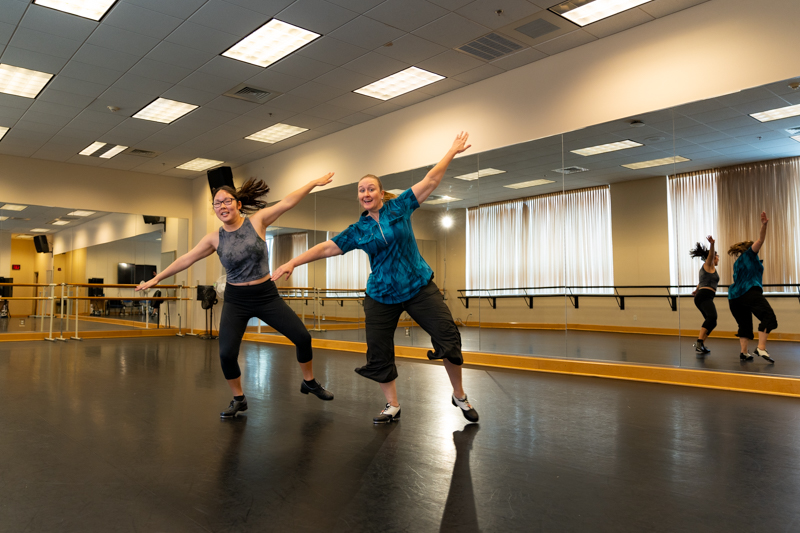
Read time:
The sound. The rhythm, The movement.
That’s what draws Mia Kennedy ‘24 musical theater, to tap and ignites her passion. When she puts on tap shoes, they transport her to a different place, one that inspires joy and motivates her to keep learning and to keep tapping.
Her love of tap motivated her to delve deep into the history of the dance style, which dates back to the early 19th century.
Kennedy, a Summer Scholar, spent the summer researching tap, absorbing its history and creating a textbook of sorts that lays out where it came from and what it looks like now. Kennedy has been working with Laura Lloyd, a professor of dance and musical theater, to bring her project to fruition.
“It’s like an encyclopedia of tap,” said Kennedy.
The resource will be used to help students who take tap classes. Kennedy’s guide lays out tap steps, important names associated with the style, and takes a deep dive into how tap has influenced Broadway through the years. Tap has been influenced by many styles over the decades. Two prominent schools of tap are Broadway and rhythm. Kennedy and Lloyd are focused on Broadway.
“I have taught for a long time,” Lloyd said. “A Broadway tap textbook doesn’t exist. You just don’t see one focused on Broadway-style tap.”
Broadway tap is the type of show dancing seen in live stage musicals and in Hollywood films. It typically incorporates more arm movements, artistic body movements, and movements across the dance floor than rhythm tap dancing. In the 1980s, tap saw a resurgence in popularity when Broadway shows, such as “42nd Street” and “The Tap Dance Kid,” introduced new audiences to the dance style.
Lloyd and Kennedy had worked on an independent study focused on Broadway tap, and decided the subject was worth expanding into Summer Scholars.
The Summer Scholars program is a program unique to Christopher Newport where students and faculty work side by side on research projects. It is an eight-week, in-residence program that brings students and faculty together to work collaboratively to answer a research question. Scholars receive a housing allowance and stipend.
Kennedy, who knew she wanted to do research coming into college, took note of the void and decided to fill it by focusing on her Summer Scholars project on tap dancing. “I learned so much,” she said. “I have always loved doing research.”
To bring her study of tap to life, Kennedy and Lloyd traveled to New York City to see Broadway shows featuring tap and also took a Broadway tap class. It was a fantastic way to see the artform on some of the world’s most famous stages.
“It was fun going to see those shows,” Kennedy said. “It was great to notice that all the steps that we had talked about were used. So, we were like, ‘yes, we’re on the right path.’ I think we just missed one step. So we brought that back and added that into our list of steps.”
The resource that Kennedy and Lloyd are creating includes a written component and video piece in which Kennedy performs each step in a way in which they are indexed for reference. Students will be able to consult the guide for detailed direction on how to properly perform each tap step and learn its accompanying history. For tap students, the guide is likely to be most helpful as they work to advance the skills.
“There really isn’t an opportunity to go deeply into the history of tap, at least with any class offered here,” Kennedy said. “And so, being able to delve into a style that I really like is, I think, a unique opportunity that’s kind of tailored specifically to what is special to me.”
Being able to work one-on-one with Lloyd to become well-versed in something she loves, and to create something that will impart knowledge and expertise to other tap lovers, has been a dynamic and rewarding experience for Kennedy.
“Dance is my favorite part of musical theater, so having a wonderful relationship with one of my dance professors has been really great,” Kennedy said. “I think it’s setting me up for success here, and for potential connections in the future.”
Lloyd agreed, saying she has also learned a lot through the experience.
“It’s been a lovely relationship that isn’t just teacher to student, but one in which she’s teaching me as well,” Lloyd said. “It also has meant a lot to me to have a student who really wants to look at research, especially in musical theater.
“Most of it is performance based and so we go into class and it’s like, ‘learn the steps, let’s put them together into the dance and let’s perform it’” Lloyd said. “It’s been pretty special to dig a little deeper, to have somebody really interested in the history of the steps and why they are what they are, and then to be able to, you know, go experience tap in New York City one-on-one and really talk about it. It made it a little more special, a little more personal.”